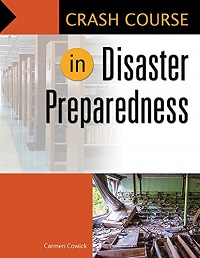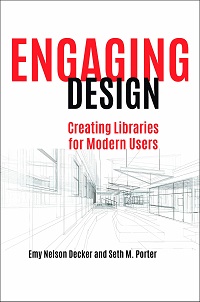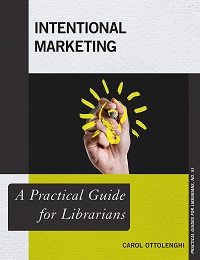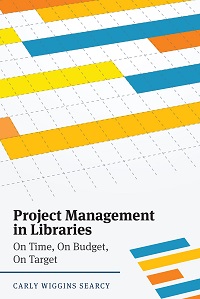Disaster Preparedness, Modern Library Design, Project Management | Professional Media, March 2019
This month's professional media reviews include an excellent tool for training and planning sessions for library staff, boards, and government officials; useful strategies and ideas for library administrators and marketers; and a solid playbook for managers overseeing all types of projects.
 Cowick, Carmen. Crash Course in Disaster Preparedness. Libraries Unlimited: Teacher Ideas. 2018. 120p. bibliog. index. ISBN 9781440860515. pap. $45; ebk. ISBN 9781440860522. PRO MEDIA
Cowick, Carmen. Crash Course in Disaster Preparedness. Libraries Unlimited: Teacher Ideas. 2018. 120p. bibliog. index. ISBN 9781440860515. pap. $45; ebk. ISBN 9781440860522. PRO MEDIA
This no-nonsense workbook from Cowick (director of preservation svcs., Preserve This) helps libraries prepare for disasters. Many libraries have emergency plans but may not have considered salvage priorities or keeping a copy of their plans off site. Here, the author discusses organizing a disaster team and provides worksheets with pertinent tasks. She covers fire- and water-related issues, mold and pests, medical emergencies, large-scale theft by patrons and staff, active shooters, bomb threats, hurricanes, tornadoes, and earthquakes, addressing prevention, response, and salvage and recovery procedures, as well as communication. Also included are exercises and drills for staff training, an annotated bibliography, and a chapter on technology tools. Though the real-life examples aren’t detailed case studies, readers may find that knowing another library has dealt with an infestation of bedbugs, for instance, gives them a starting point.
VERDICT An excellent tool for training and planning sessions for library staff, boards, and government officials. —Susan Belsky, Oshkosh P.L., WI
 Decker, Emy Nelson & Seth M. Porter. Engaging Design: Creating Libraries for Modern Users. Libraries Unlimited: Teacher Ideas. 2018. 180p. bibliog. index. ISBN 9781440856129. pap. $70; ebk. ISBN 9781440856136. PRO MEDIA
Decker, Emy Nelson & Seth M. Porter. Engaging Design: Creating Libraries for Modern Users. Libraries Unlimited: Teacher Ideas. 2018. 180p. bibliog. index. ISBN 9781440856129. pap. $70; ebk. ISBN 9781440856136. PRO MEDIA
The focus on user experience within libraries has expanded from simplifying access to services to rethinking the design of physical and digital spaces. Decker (NextGen public svcs. manager, Georgia Tech. Lib.; coeditor, Handbook of Research on Disaster Management and Contingency Planning in Modern Libraries ) and Porter (Stokes Lib., Woodrow Wilson Sch. of Public and International Affairs, Princeton Univ.) call this “engaging design.” They posit that by taking a holistic approach to design, libraries can enhance user experience and encourage lifelong learning. The authors follow a fictional librarian’s journey through the renovation of a university library. Decker and Porter define good design and discuss how to incorporate it into interior and exterior spaces, websites, and in-person and online instructional technology and programs. They also emphasize creating spaces and programs that are accessible to people with special needs. However, while this is a good literature review on design principles and pedagogical e-learning, the lack of real-life examples and paucity of illustrations prevent it from being as practical a tool for librarians and administrators as the authors claim.
VERDICT An additional purchase for librarians curious about library design.—Donna Marie Smith, Palm Beach Cty. Lib. Syst., FL
 Ottolenghi, Carol. Intentional Marketing. Rowman & Littlefield. (Practical Guides for Librarians). 2018. 188p. photos. index. ISBN 9781538108482. pap. $65; ebk. ISBN 9781538108499. PRO MEDIA
Ottolenghi, Carol. Intentional Marketing. Rowman & Littlefield. (Practical Guides for Librarians). 2018. 188p. photos. index. ISBN 9781538108482. pap. $65; ebk. ISBN 9781538108499. PRO MEDIA
The public forms an impression of a library based on interactions with library staff, knowledge of collections, awareness of programs, and use of the physical spaces and virtual services. Ottolenghi (director of library svcs., the Office of the Ohio Attorney General), who has experience with public relations and marketing in public libraries, argues that since everything is marketing, the library needs to be intentional in its messaging and present a unified approach to communication. The author advocates being user-centric and addressing the needs and wants of current and potential clients. The goal is to show the library doing good work and to build and maintain a relationship with users. This book covers marketing theory but is more of a handbook on establishing a marketing program, with guidance and examples. Twenty-nine marketing snapshots offer tips from many types of libraries; for instance, the Contra Costa Library System teamed with their local transit authority to produce Snap & Go posters with QR codes to allow commuters smartphone access to ebooks, library staff, and more.
VERDICT Library administrators and marketers will find here many useful strategies and ideas.—Judy Solberg, Sacramento, CA
 Searcy, Carly Wiggins. Project Management in Libraries: On Time, on Budget, on Target. ALA. 2018. 123p. bibliog. index. ISBN 9780838917190. $54.99. PRO MEDIA
Searcy, Carly Wiggins. Project Management in Libraries: On Time, on Budget, on Target. ALA. 2018. 123p. bibliog. index. ISBN 9780838917190. $54.99. PRO MEDIA
Unlike routine activities, which are ongoing and governed by established procedures, projects are short-term and designed to create a unique service or product. Searcy (government information librarian, McNeese State Univ.) describes the basic skills and five phases of timely, cost-effective project management: initiating, planning, executing, monitoring, and closing. The author refers to the same hypothetical project throughout, making it easier for readers to understand how these stages lead to a successful outcome. Searcy also provides guidance on choosing software packages. The clear, encouraging writing will instill confidence in readers, and a well-chosen bibliography adds to the work’s value.
VERDICT A solid playbook for managers overseeing all types of projects. Those who have struggled with this skill in the past, as well as those new to it, will find this title invaluable.—Lydia Olszak, Bosler Memorial Lib., Carlisle, PA
RELATED
ALREADY A SUBSCRIBER? LOG IN
We are currently offering this content for free. Sign up now to activate your personal profile, where you can save articles for future viewing









Add Comment :-
Comment Policy:
Comment should not be empty !!!